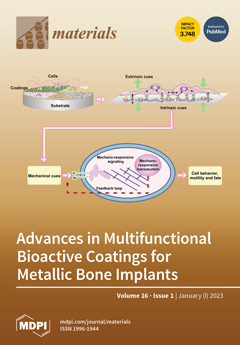A silver sulfide (Ag
2S) semiconductor photocatalyst film has been successfully synthesized using a solution casting method. To produce the photocatalyst films, two types of Ag
2S powder were used: a commercialized and synthesized powder. For the commercialized powder (CF/comAg
2
[...] Read more.
A silver sulfide (Ag
2S) semiconductor photocatalyst film has been successfully synthesized using a solution casting method. To produce the photocatalyst films, two types of Ag
2S powder were used: a commercialized and synthesized powder. For the commercialized powder (CF/comAg
2S), the Ag
2S underwent a rarefaction process to reduce its crystallite size from 52 nm to 10 nm, followed by incorporation into microcrystalline cellulose using a solution casting method under the presence of an alkaline/urea solution. A similar process was applied to the synthesized Ag
2S powder (CF/syntAg
2S), resulting from the co-precipitation process of silver nitrate (AgNO
3) and thiourea. The prepared photocatalyst films and their photocatalytic efficiency were characterized by Fourier transform infrared spectroscopy (FTIR), X-ray diffraction (XRD), and UV-visible spectroscopy (UV-Vis). The results showed that the incorporation of the Ag
2S powder into the cellulose films could reduce the peak intensity of the oxygen-containing functional group, which indicated the formation of a composite film. The study of the crystal structure confirmed that all of the as-prepared samples featured a monoclinic acanthite Ag
2S structure with space group P
21/C. It was found that the degradation rate of the methylene blue dye reached 100% within 2 h under sunlight exposure when using CF/comAg
2S and 98.6% for the CF/syntAg
2S photocatalyst film, and only 48.1% for the bare Ag
2S powder. For the non-exposure sunlight samples, the degradation rate of only 33–35% indicated the importance of the semiconductor near-infrared (NIR) Ag
2S photocatalyst used.
Full article






